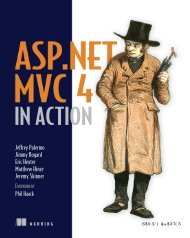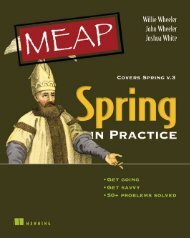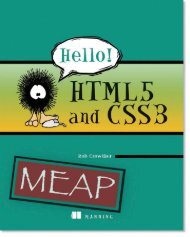jQuery in Action - Manning Publications
jQuery in Action - Manning Publications
jQuery in Action - Manning Publications
You also want an ePaper? Increase the reach of your titles
YUMPU automatically turns print PDFs into web optimized ePapers that Google loves.
<strong>jQuery</strong> fundamentals<br />
Select<strong>in</strong>g DOM elements for manipulation is a common need <strong>in</strong> web pages, but<br />
some th<strong>in</strong>gs that we’ll also need to do don’t <strong>in</strong>volve DOM elements at all. Let’s take a<br />
brief look at what <strong>jQuery</strong> offers beyond element manipulation.<br />
1.3.2 Utility functions<br />
Even though wrapp<strong>in</strong>g elements to be operated upon is one of the most frequent uses<br />
of <strong>jQuery</strong>’s $() function, that’s not the only duty to which it’s assigned. One of its<br />
additional duties is to serve as the namespace prefix for a handful of general-purpose<br />
utility functions. Because so much power is given to page authors by the <strong>jQuery</strong> wrapper<br />
created as a result of a call to $() with a selector, it’s somewhat rare for most page<br />
authors to need the services provided by some of these functions. In fact, we won’t be<br />
look<strong>in</strong>g at the majority of these functions <strong>in</strong> detail until chapter 6 as a preparation for<br />
writ<strong>in</strong>g <strong>jQuery</strong> plug<strong>in</strong>s. But you will see a few of these functions put to use <strong>in</strong> the<br />
upcom<strong>in</strong>g sections, so we’ll briefly <strong>in</strong>troduce them here.<br />
The notation for these functions may look odd at first. Let’s take, for example, the<br />
utility function for trimm<strong>in</strong>g str<strong>in</strong>gs. A call to it could look like this:<br />
var trimmed = $.trim(someStr<strong>in</strong>g);<br />
If the $. prefix looks weird to you, remember that $ is an identifier like any other <strong>in</strong><br />
JavaScript. Writ<strong>in</strong>g a call to the same function us<strong>in</strong>g the <strong>jQuery</strong> identifier, rather than<br />
the $ alias, may look a bit less odd:<br />
var trimmed = <strong>jQuery</strong>.trim(someStr<strong>in</strong>g);<br />
Here it becomes clear that the trim() function is merely namespaced by <strong>jQuery</strong> or its<br />
$ alias.<br />
NOTE Even though these elements are called the utility functions <strong>in</strong> <strong>jQuery</strong><br />
documentation, it’s clear that they’re actually methods of the $() function (yes,<br />
<strong>in</strong> JavaScript, functions can have their own methods). We’ll put aside this<br />
technical dist<strong>in</strong>ction and use the term utility function to describe these methods<br />
so as not to <strong>in</strong>troduce term<strong>in</strong>ology that conflicts with the onl<strong>in</strong>e documentation.<br />
We’ll explore one of these utility functions that helps us to extend <strong>jQuery</strong> <strong>in</strong><br />
section 1.3.5, and one that helps <strong>jQuery</strong> peacefully coexist with other client-side<br />
libraries <strong>in</strong> section 1.3.6. But first, let’s look at another important duty that <strong>jQuery</strong>’s<br />
$() function performs.<br />
1.3.3 The document ready handler<br />
When embrac<strong>in</strong>g Unobtrusive JavaScript, behavior is separated from structure, so<br />
we’re perform<strong>in</strong>g operations on the page elements outside of the document markup<br />
that creates them. In order to achieve this, we need a way to wait until the DOM elements<br />
of the page are fully realized before those operations execute. In the radio<br />
group example, the entire body must load before the behavior can be applied.<br />
11










